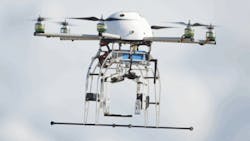Jeff Bezos’ vision of delivery drones, shared with the world via 60 Minutes last Sunday, inspired others with drones on their minds to launch. Turns out UPS and Google are busy testing their own versions of these flying tarantulas, and there are other drone masters elsewhere in the world who are even further ahead in their applications.
One of you already answered this question after reading our last blog which touched on it. Ken MacDonald, president of M & G Materials Handling Company, a Yale lift truck dealer in East Providence, RI, talked about it in LinkedIn’s Forklift Professionals discussion group. He said he believes this technology will improve how material handling distributors serve customers.
I had to know more. How would a distributor use a drone, I asked him in a follow-up e-mail.
Imagine a forklift needing service. It has the technology to send an electronic message to its manufacturer stating the hours used and the components that will need replacing. The manufacturer would then send the part directly to the customer, by drone.
Isn’t that the distributor’s job? Ken thinks that job will change with the adoption of part delivery by drone. That will allow the dealer to focus on service rather than stocking parts.
“The tech will show up to repair in a much smaller vehicle, which will cost the distributor less to purchase and operate,” MacDonald believes. “Dealerships will not need large parts distribution, as many people or as large a facility.”
He even sees the possibility that OEMs could play a more visible service role with customers by contracting with local service techs.
“We need to embrace the technology, adapt, and restructure our dealership as these technologies evolve,” he wrote.
But how workable is drone technology? With OEMs, retailers and parcel carriers coming out with their own versions, how will they keep from colliding with each other?
That will ultimately be up to the Federal Aviation Administration—and the technology.
“Technology will create travel lanes like the air travel of today,” MacDonald concluded. “Super computers will have the capacity to monitor, direct and do evasive maneuvers. We now have AGVs and smart cars operating that way. Weather, of course, will be the deterrent for small drones.”
As a fairly frequent air traveler who’s had his share of flight delays, I can envision shippers living that hell vicariously through their shipments. Drones may not be a pretty word, but I can imagine some new labels applied to them if future air traffic controllers make them jockey for air space and arrival times. In that case, the name drone will sound poetic by comparison with other names they might be called.
About the Author
Tom Andel Blog
former Editor-in-Chief
As editor-in-chief from 2010-2014, Tom Andel oversaw the strategic development of MH&L and MHLnews.com, bringing 30+ years of thought leadership and award winning coverage of supply chain, manufacturing logistics and material handling. Throughout his career he also served in various editorial capacities at other industry titles, including Transportation & Distribution, Material Handling Engineering, Material Handling Management (predecessors to MH&L), as well as Logistics Management and Modern Materials Handling. Andel is a three-time finalist in the Jesse H. Neal Business Journalism Awards, the most respected editorial award in B2B trade publishing, and a graduate of Cleveland’s Case Western Reserve University.

